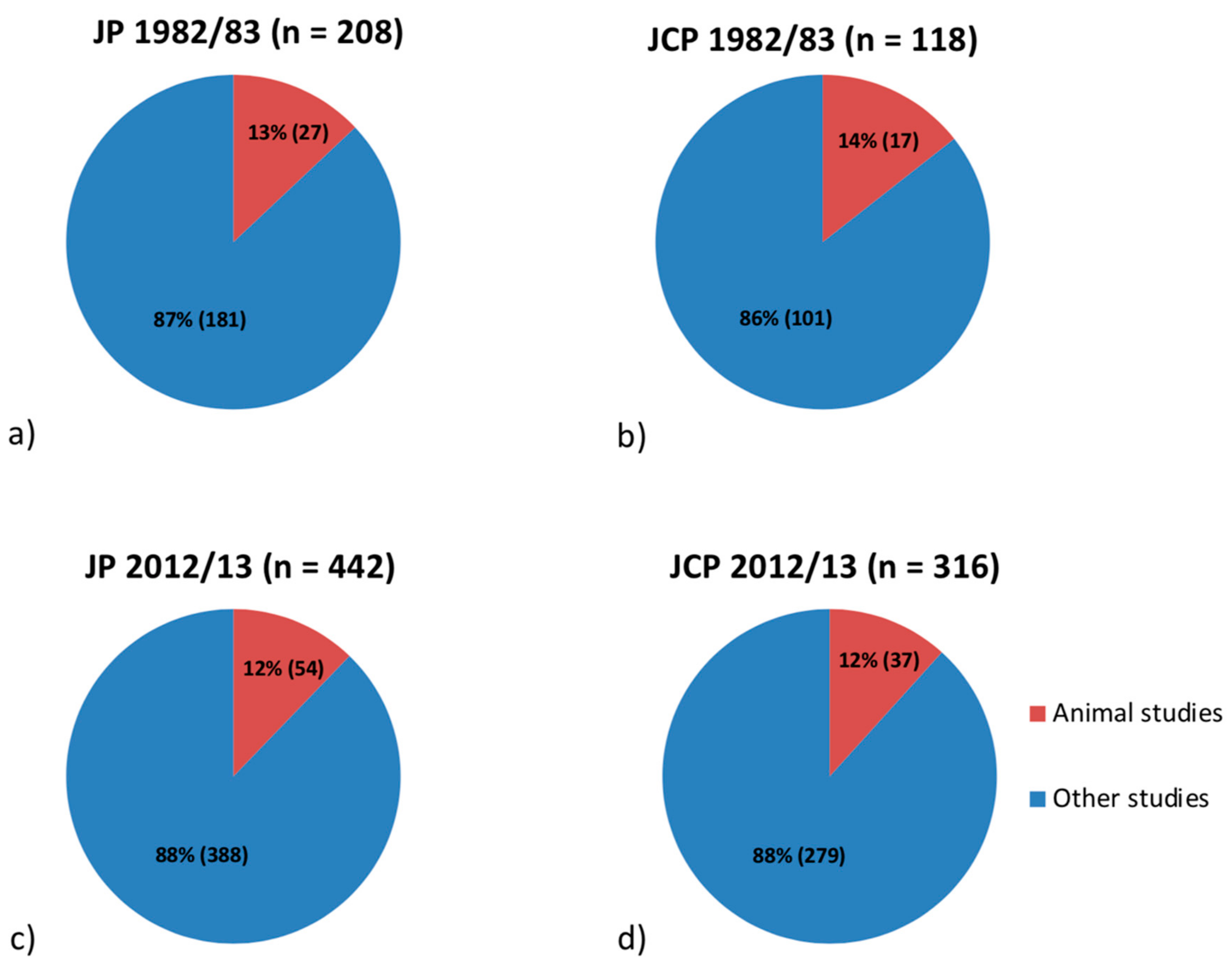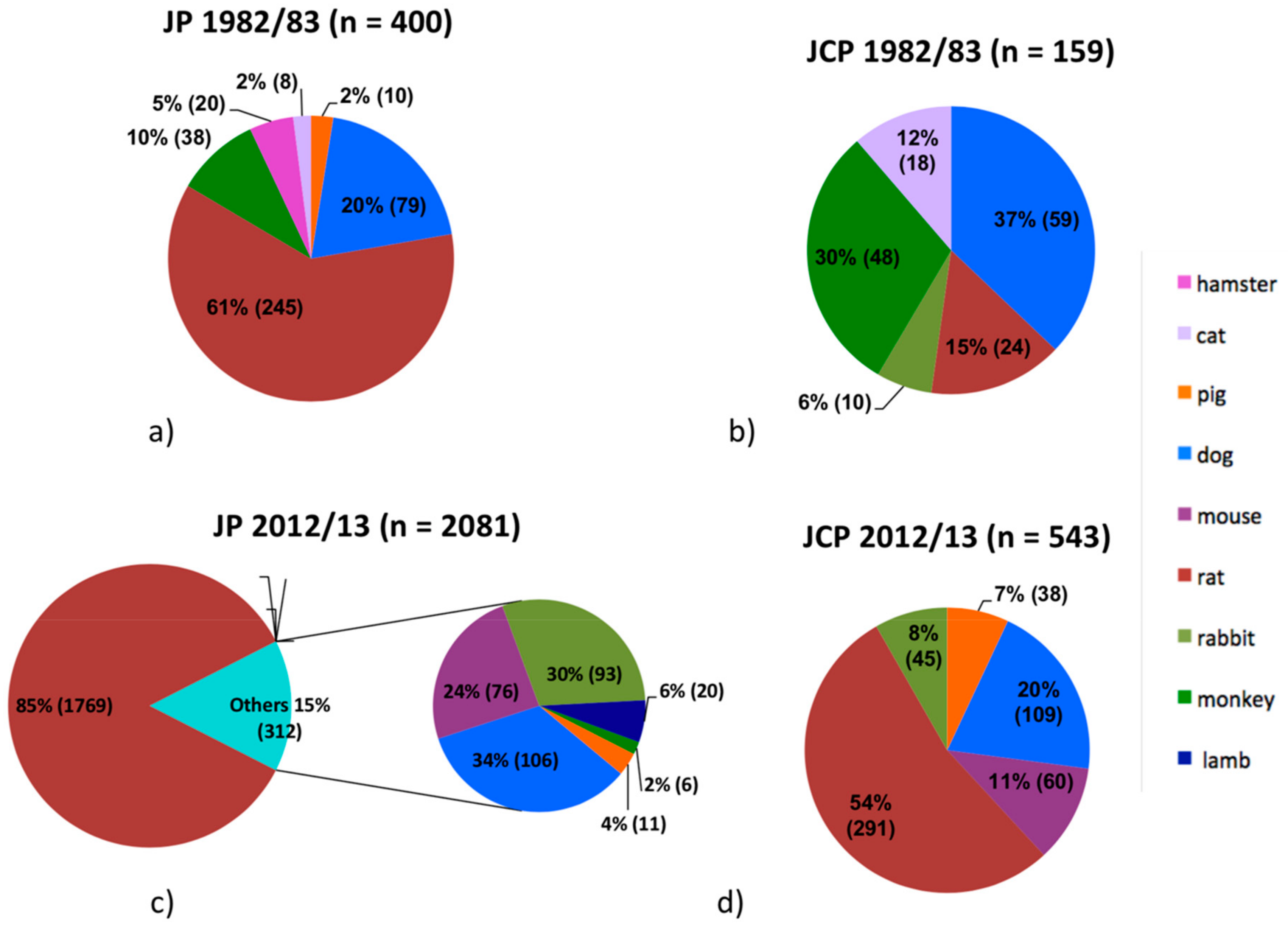Animal Experiments in Periodontal and Peri-Implant Research: Are There Any Changes?
Abstract
1. Introduction
2. Materials and Methods
2.1. Focused Questions
2.2. Literature Search Strategy
Selected Journals and Time Frame
2.3. Evaluation of Publications
2.3.1. Inclusion Criteria and Applied Definition
2.3.2. Exclusion Criteria and Applied Definition
3. Results
3.1. Population/Participants (P)—Number of Screened Articles and Authors
3.2. Intervention (I)/Comparison (C)—Content of Screened Articles
3.3. Outcome (O)
3.3.1. How Many Publications Dealing with Experiments on Animals Were Published in the JP and JCP in the Years 1982/83 and 2012/13?
3.3.2. Was there a Change Regarding the Average Number of Animals Examined in the Animal Studies over Time?
3.3.3. Was there a Difference Regarding the Animal Species Examined between these Two Periodontal Journals?
3.3.4. Where did the Publications Originate from?
4. Discussion
5. Conclusions
- (1)
- to ask a clear and precise research question with respect to the expected benefit for the therapy of human diseases;
- (2)
- to focus on a strong adherence to the 3-R’s strategy, i.e., to replace, reduce, and refine animal experiments;
- (3)
- to apply a high standard of reporting and analysis of data;
- (4)
- to adhere to quality guidelines such as ARRIVE; and
- (5)
- to critically review submitted manuscripts with respect to points 1, 2, 3, and 4.
Author Contributions
Funding
Conflict of Interest
References
- NZZ. Brandanschlag auf Vasellas Tiroler Jagdsitz. 2009. Available online: https://www.nzz.ch/vasella_brand_jagdsitz_tirol-1.3272074 (accessed on 5 October 2017).
- Abbott, A. Basel Declaration defends animal research. Nature 2010, 468, 742. [Google Scholar] [CrossRef] [PubMed]
- Basel Declaration. A Call for More Trust, Transparency and Communication on Animal Research. 2011. Available online: http://www.basel-declaration.org (accessed on 5 October 2017).
- Cruelty Free International. Facts and Figures on Animal Testing. 2017. Available online: https://www.crueltyfreeinternational.org/why-we-do-it/facts-and-figures-animal-testing (accessed on 19 October 2017).
- Egelberg, J. Permeability of the dento-gingival blood vessels. 3. Chronically inflamed gingivae. J. Periodontal Res. 1966, 1, 287–296. [Google Scholar] [CrossRef]
- Egelberg, J. Permeability of the dento-gingival blood vessels. II. Clinically healthy gingivae. J. Periodontal Res. 1966, 1, 276–286. [Google Scholar] [CrossRef]
- Egelberg, J. Permeability of the dento-gingival blood vessels. 1. Application of the vascular labelling method and gingival fluid measurements. J. Periodontal Res. 1966, 1, 180–191. [Google Scholar] [CrossRef]
- Egelberg, J. The blood vessels of the dento-gingival junction. J. Periodontal Res. 1966, 1, 163–179. [Google Scholar] [CrossRef]
- Perlstein, M.I.; Bissada, N.F. Influence of Obesity and Hypertension on Severity of Periodontitis in Rats. Oral Surg. Oral Med. Oral Pathol. Oral Radiol. Endod. 1977, 43, 707–719. [Google Scholar] [CrossRef]
- Brånemark, P.I. Osseointegration and its experimental background. J. Prosthet. Dent. 1983, 50, 399–410. [Google Scholar] [CrossRef]
- Hamp, S.E.; Lindhe, J.; Loe, H. Experimental periodontitis in the beagle dog. J. Periodontal Res. 1972, 10, 13–14. [Google Scholar]
- Mawardi, H.; Giro, G.; Kajiya, M.; Ohta, K.; Almazrooa, S.; Alshwaimi, E.; Woo, S.B.; Nishimura, I.; Kawai, T. A role of oral bacteria in bisphosphonate-induced osteonecrosis of the jaw. J. Dent. Res. 2011, 90, 1339–1345. [Google Scholar] [CrossRef]
- Hammarström, L.; Heijl, L.; Gestrelius, S. Periodontal regeneration in a buccal dehiscence model in monkeys after application of enamel matrix proteins. J. Clin. Periodontol. 1997, 24, 669–677. [Google Scholar] [CrossRef]
- Ericsson, I.; Persson, L.G.; Berglundh, T.; Edlund, T.; Lindhe, J. The effect of antimicrobial therapy on periimplantitis lesions. An experimental study in the dog. Clin. Oral Implant. Res. 1996, 7, 320–328. [Google Scholar] [CrossRef]
- Seok, J.; Warren, H.S.; Cuenca, A.G.; Mindrinos, M.N.; Baker, H.V.; Xu, W.; Richards, D.R.; McDonald-Smith, G.P.; Gao, H.; Hennessy, L.; et al. Genomic responses in mouse models poorly mimic human inflammatory diseases. Proc. Natl. Acad. Sci. USA 2013, 110, 3507–3512. [Google Scholar] [CrossRef] [PubMed]
- Bundesamt für Veterinärwesen BVET. Anzahl Tiere von 1983–2016. 2016. Available online: http://tv-statistik.ch/de/statistik/index.php#a1 (accessed on 5 October 2017).
- Faggion, C.M., Jr.; Schmitter, M.; Tu, Y.K. Assessment of replication of research evidence from animals to humans in studies on peri-implantitis therapy. J. Dent. 2009, 37, 737–747. [Google Scholar] [CrossRef]
- Faggion, C.M., Jr.; Giannakopoulos, N.N.; Listl, S. Risk of bias of animal studies on regenerative procedures for periodontal and peri-implant bone defects—A systematic review. J. Clin. Periodontol. 2011, 38, 1154–1160. [Google Scholar] [CrossRef]
- Faggion, C.M., Jr.; Listl, S.; Giannakopoulos, N.N. The methodological quality of systematic reviews of animal studies in dentistry. Vet. J. 2012, 192, 140–147. [Google Scholar] [CrossRef] [PubMed]
- Faggion, C.M., Jr.; Aranda, L.; Diaz, K.T.; Shih, M.C.; Tu, Y.K.; Alarcon, M.A. The Quality of Reporting of Measures of Precision in Animal Experiments in Implant Dentistry: A Methodological Study. Int. J. Oral Maxillofac. Implant. 2016, 31, 1312–1319. [Google Scholar] [CrossRef] [PubMed]
- Faggion, C.M., Jr.; Diaz, K.T.; Aranda, L.; Gabel, F.; Listl, S.; Alarcon, M.A. The risk of bias of animal experiments in implant dentistry: A methodological study. Clin. Oral Implants Res. 2017, 28, e39–e45. [Google Scholar] [CrossRef] [PubMed]
- Staubli, N.; Schmidt, J.C.; Buset, S.L.; Gutekunst, C.J.; Rodriguez, F.R.; Schmidlin, P.R.; Walter, C. Traditional or regenerative periodontal surgery?—A comparison of the publications between two periodontal journals over time. Clin. Oral Investig. 2018, 22, 29–46. [Google Scholar] [CrossRef] [PubMed]
- JCR Science Edition. Journals with Impact Factors on Dentistry, Oral Surgery & Medicine. 2016. Available online: https://www.google.ch/url?sa=t&rct=j&q=&esrc=s&source=web&cd=1&ved=0ahUKEwiamaPS-dXRAhWrAsAKHQ2ICl8QFggaMAA&url=https%3A%2F%2Flib.hku.hk%2Fsites%2Fall%2Ffiles%2Ffiles%2Fdenlib%2Fimpact%2520factor%25202015.pdf&usg=AFQjCNF1ow8h7gTqnLNhz53Icx5R5nf4MQ (accessed on 20 September 2017).
- Nyman, S.; Gottlow, J.; Karring, T.; Lindhe, J. The regenerative potential of the periodontal ligament. An experimental study in the monkey. J. Clin. Periodontol. 1982, 9, 257–265. [Google Scholar] [CrossRef]
- Park, J.B.; Ko, Y.; Park, Y.G. Letters to the editor: Re: Bibliometrics study on authorship trends in periodontal literature from 1995 to 2010. J. Periodontol. 2015, 86, 7. [Google Scholar] [CrossRef]
- Miller, S.A.; Forrest, J.L. Enhancing your practice through evidence-based decision making: PICO, learning how to ask good questions. J. Evid. Based Dent. Pract. 2001, 1, 136–141. [Google Scholar] [CrossRef]
- Siddique, H. Number of Animal Experiments Continues to Rise in UK. 2014. Available online: https://www.theguardian.com/science/2014/jul/10/animal-experiments-rise-again-uk-genetic-research (accessed on 5 October 2017).
- Russell, W.M.S.; Burch, R.L. The Principles of Humane Experimental Technique; Methuen: London, UK, 1959; pp. 69–154. [Google Scholar]
- Home Office. User Guide to Annual Statistics of Scientific Procedures on Living Animals Great Britain. 2017. Available online: https://www.gov.uk/government/uploads/system/uploads/attachment_data/file/626965/guide-animal-procedures-commentary.pdf (accessed on 9 October 2017).
- Reichman, J.H. Intellectual Property in the Twenty-First Century: Will the Developing Countries Lead or Follow? Houst. Law Rev. 2009, 46, 1115–1185. [Google Scholar]
- Geminiani, A.; Ercoli, C.; Feng, C.; Caton, J.G. Bibliometrics study on authorship trends in periodontal literature from 1995 to 2010. J. Periodontol. 2014, 85, e136–e143. [Google Scholar] [CrossRef] [PubMed]
- Kretzer, M. Countries Around the World Work to Ban Cosmetics Testing on Animals. 2015. Available online: https://www.peta.org/blog/countries-around-the-world-work-to-ban-cosmetics-testing-on-animals/ (accessed on 20 October 2017).
- European Commission. Full EU Ban on Animal Testing for Cosmetics Enters into Force. 2013. Available online: http://europa.eu/rapid/press-release_IP-13-210_en.htm (accessed on 5 October 2017).
- Spencer, N. PETA: China’s New Regulation Removes Animal Testing Procedure. 2017. Available online: https://www.cosmeticsdesign-asia.com/Article/2017/01/24/PETA-China-s-new-regulation-removes-animal-testing-procedure (accessed on 7 November 2017).
- Page, R.C.; Kornman, K.S. The pathogenesis of human periodontitis: An introduction. Periodontology 2000 1997, 14, 9–11. [Google Scholar] [CrossRef]
- Meyle, J.; Chapple, I. Molecular aspects of the pathogenesis of periodontitis. Periodontology 2000 2015, 69, 7–17. [Google Scholar] [CrossRef]
- Takao, K.; Miyakawa, T. Genomic responses in mouse models greatly mimic human inflammatory diseases. Proc. Natl. Acad. Sci. USA 2015, 112, 1167–1172. [Google Scholar] [CrossRef] [PubMed]
- Amiri-Jezeh, M.; Rateitschak, E.; Weiger, R.; Walter, C. The impact of the margin of restorations on periodontal health—A review. Schweiz. Mon. Für Zahnmed. 2006, 116, 606–613. [Google Scholar]
- Ramseier, C.A.; Warnakulasuriya, S.; Needleman, I.G.; Gallagher, J.E.; Lahtinen, A.; Ainamo, A.; Alajbeg, I.; Albert, D.; Al-Hazmi, N.; Antohé, M.E.; et al. Consensus Report: 2nd European Workshop on Tabacco Use Prevention and Cessation for Oral Health Professionals. Int. Dent. J. 2010, 60, 3–6. [Google Scholar] [PubMed]
- Rodriguez, F.R.; Paganoni, N.; Weiger, R.; Walter, C. Lower Educational Level is a Risk Factor for Tooth Loss—Analysis of a Swiss Population (KREBS Project). Oral Health Prev. Dent. 2017, 15, 139–145. [Google Scholar] [PubMed]
- Kilkenny, C.; Browne, W.; Cuthill, I.C.; Emerson, M.; Altman, D.G. Animal research: Reporting in vivo experiments: The ARRIVE guidelines. Br. J. Pharmacol. 2010, 160, 1577–1579. [Google Scholar] [CrossRef] [PubMed]


© 2019 by the authors. Licensee MDPI, Basel, Switzerland. This article is an open access article distributed under the terms and conditions of the Creative Commons Attribution (CC BY) license (http://creativecommons.org/licenses/by/4.0/).
Share and Cite
Staubli, N.; Schmidt, J.C.; Rinne, C.A.; Signer-Buset, S.L.; Rodriguez, F.R.; Walter, C. Animal Experiments in Periodontal and Peri-Implant Research: Are There Any Changes? Dent. J. 2019, 7, 46. https://doi.org/10.3390/dj7020046
Staubli N, Schmidt JC, Rinne CA, Signer-Buset SL, Rodriguez FR, Walter C. Animal Experiments in Periodontal and Peri-Implant Research: Are There Any Changes? Dentistry Journal. 2019; 7(2):46. https://doi.org/10.3390/dj7020046
Chicago/Turabian StyleStaubli, Noémie, Julia C. Schmidt, Carin A. Rinne, Sabrina L. Signer-Buset, Fabiola R. Rodriguez, and Clemens Walter. 2019. "Animal Experiments in Periodontal and Peri-Implant Research: Are There Any Changes?" Dentistry Journal 7, no. 2: 46. https://doi.org/10.3390/dj7020046
APA StyleStaubli, N., Schmidt, J. C., Rinne, C. A., Signer-Buset, S. L., Rodriguez, F. R., & Walter, C. (2019). Animal Experiments in Periodontal and Peri-Implant Research: Are There Any Changes? Dentistry Journal, 7(2), 46. https://doi.org/10.3390/dj7020046



